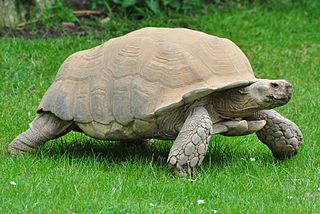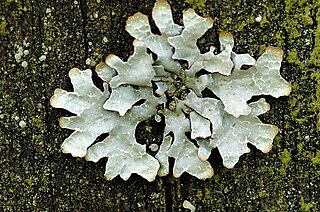
The African spurred tortoise, also called the sulcata tortoise, is an endangered species of tortoise inhabiting the southern edge of the Sahara Desert, the Sahel, in Africa. It is the largest mainland species of tortoise in Africa, and the third-largest in the world, after the Galapagos tortoise and Aldabra giant tortoise. It is the only living species in its genus, Centrochelys.

Callitris sulcata is a species of conifer in the cypress family, Cupressaceae. Its common name is Sapin de Comboui. It is endemic to New Caledonia, where it grows only in three forested river valleys. It is an endangered species with a global population of no more than 2500 individuals.

Anemonia sulcata, or Mediterranean snakelocks sea anemone, is a species of sea anemone in the family Actiniidae from the Mediterranean Sea. Whether A. sulcata should be recognized as a synonym of A. viridis remains a matter of dispute.
La Serre is a commune in the Aveyron department in southern France.

Parmelia sulcata, commonly known as the hammered shield lichen or cracked-shield lichen, is a foliose lichen in the family Parmeliaceae. First described by Thomas Taylor in 1836, it is one of the most prevalent lichen species globally, known for its resilience to pollution and cosmopolitan distribution across temperate and cold regions of both hemispheres. P. sulcata forms a circular thallus up to 10 cm (4 in) in diameter, with a glaucous white to grey upper surface and a black lower surface, featuring broadly lobed structures with both marginal and laminal soralia and a distinctive reticulate pattern of pseudocyphellae.

Tudorella sulcata is a species of land snail which has an operculum, a terrestrial gastropod mollusk in the family Pomatiidae.

Terebralia is a genus of sea snails, marine gastropod mollusks in the family Potamididae.

Sybra is a genus of beetles in the family Cerambycidae, containing the following species:

Sanbokan is a Japanese citrus fruit of the Wakayama prefecture similar to a mandarin orange, easily distinguished by its pronounced basal nipple.
Sybra biguttula is a species of beetle in the family Cerambycidae. It was described by Breuning in 1964. It contains two subspecies, Sybra biguttula biguttula and Sybra biguttula samarensis.
Sybra iconica is a species of beetle in the family Cerambycidae. It was described by Pascoe in 1865. It contains two subspecies, Sybra iconica clarevitticollis and Sybra iconica iconica.

Sybra umbratica is a species of beetle in the family Cerambycidae. It was described by Pascoe in 1865.
Sybra uenoi is a species of beetle in the family Cerambycidae. It was described by Hayashi in 1956. It is known from Japan.
Sybra bioculata is a species of beetle in the family Cerambycidae. It was described by Pic in 1925. It contains four subspecies: Sybra bioculata bioculata, Sybra bioculata quadrinotata, Sybra bioculata sikkimana, and Sybra bioculata tigrina.

Sybra ordinata is a species of beetle in the family Cerambycidae. It was described by Henry Walter Bates in 1873.
Sybra pascoei is a species of beetle in the family Cerambycidae. It was described by Lameere in 1893.

Clavulinopsis sulcata is a clavarioid fungus in the family Clavariaceae and is the type species of the genus Clavulinopsis. It forms very long, slender, cylindrical pinkish or orange fruiting bodies that grow on the ground among plant litter. A vernacular name that has been used for the species is flame fungus.

Persoonia sulcata is a plant in the family Proteaceae and is endemic to the south-west of Western Australia. It is a small, erect or low spreading shrub with narrow, linear leaves and cylindrical yellow flowers arranged singly or in groups of up to three in leaf axils. It grows in woodland or on rocky slopes and is found in several disjunct populations.

Centrochelys is a genus of tortoise. It contains one living species, the African spurred tortoise, native to the Sahel and adjacent areas. A number of fossil species have been attributed to this genus, but their placement in the genus is considered equivocal.

Kutorginates (Kutorginata) are an extinct class of early rhynchonelliform ("articulate") brachiopods. The class contains only a single order, Kutorginida (kutorginides). Kutorginides were among the earliest rhynchonelliforms, restricted to the lower-middle part of the Cambrian Period.














